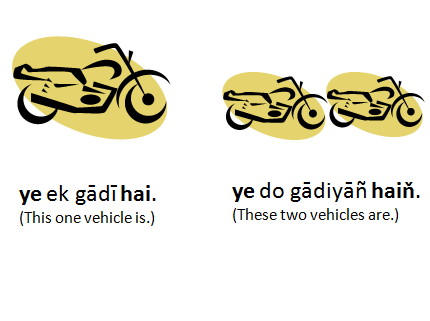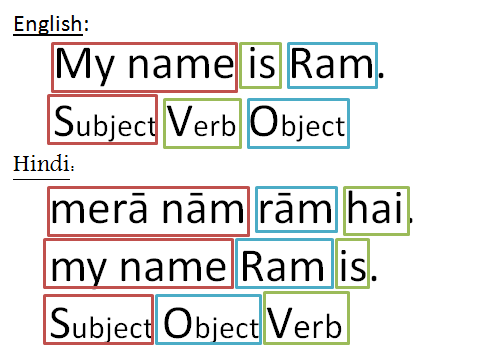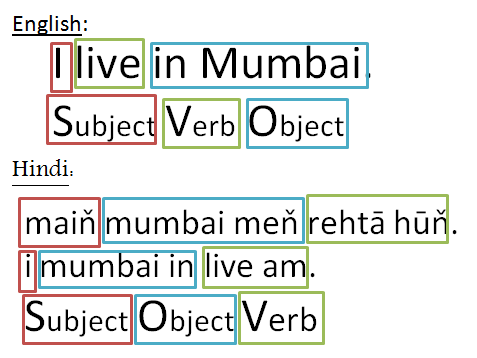Category Archives: Speaking
Indians add a ‘- जी’ (Jee) when they address relatives. This is meant for giving respect.
| Relation |
Address them as |
Refer them as |
| Mother |
मम्मी/मांMummy/Maa |
-same- |
| Father |
पापा/पिताजीPapa/Pitajee |
-same-
|
| Elder brother |
भैय्याBhaiyya |
बडा भाईBada Bhai |
| Younger brother |
<name> |
छोटा भाईChhota Bhai |
| Elder sister |
दीदीDidi |
बडी बहनBadi Behen |
| Younger sister |
<name> |
छोटी बहनChhoti Behen |
| Grandmother (maternal) |
नानीNani |
-same- |
| Grandfather (maternal) |
नानाNana |
-same- |
| Grandmother (paternal) |
दादीDadi |
-same- |
| Grandfather (paternal) |
दादाDada |
-same- |
| Wife |
|
पत्नीPatni |
| Husband |
|
पतिPati |
| Son |
|
बेटाBeta |
| Daughter |
|
बेटीBeti |
Leave a comment | tags: hindi, hindi relations, hindi vocabulary | posted in Speaking, Vocabulary
गिनती ११ से २० तक (Gintī gyārah se bīs tak ~ Counting 11 from 20 to)
11 ~ ११ ग्यारह (gyārah)
12 ~ १२ बारह (bārah)
13 ~ १३ तेरह (terah)
14 ~ १४ चौदह (chaudah)
15 ~ १५ पंद्रह (pandrah)
16 ~ १६ सोलह (solah)
17 ~ १७ सत्रह (satrah)
18 ~ १८ अठरह (aTharah)
19 ~ १९ उन्नीस (unnīs)
20 ~ २० बीस (bīs)
Leave a comment | tags: basic hindi, ginti, hindi counting | posted in Counting, Speaking
Here are some more sentences using ‘To be’ verbs. You can use the previous posts ‘To Be’ Verbs and Hindi Sentence Structure as reference.

Leave a comment | tags: basic hindi, hindi sentence structure, hona, speaking, to be | posted in Speaking, Structure
This = yah ; These = ye
That = vah ; Those = ve
But in spoken language, this, these = ye ; that, those = vo
To ask ‘What’s this?’, you will say ‘ye kyā hai?’ {literally = ‘this what is?’}
Similarly, ‘What’s that?’, you will say ‘vo kyā hai?’ {literally = ‘that what is?’}
So now, let’s use the previous post on Counting & answer the question.
ye kyā hai?

and…

Some more sentences, for example:
ye ek table hai. (English word ‘table’ more common.)
vo ek computer hai. (English word ‘computer’ more common.)
ye chār kursiyāň haiň . ~ These 4 chairs are.
vo chhe peD haiň. ~ Those 6 trees are.
So can you try some more simple sentences?
Leave a comment | tags: hindi common words, that-those, this-these | posted in Speaking
गिनती १ से १० तक (Gintī ek se das tak ~ Counting 1 from 10 to )
1 ~ १ एक (ek)
2 ~ २ दो (do)
3 ~ ३ तीन (tīn)
4 ~ ४ चार (chār)
5 ~ ५ पाँच (pāňch)
6 ~ ६ छे (chhe)
7 ~ ७ सात (sāt)
8 ~ ८ आठ (āTh)
9 ~ ९ नौ (nau)
10 ~ १० दस (das)
15 Comments | tags: ginti, hindi counting, hindi number | posted in Counting, Speaking
[M] = masculine gender ; [F] = feminine gender
s = singular ; p = plural
- door [M] ~ s: darwāzā p: darwāze
- curtain [M] ~ s: pardā p: parde
- window [F] ~ s: khiDkī p: khiDkiyāň
- newspaper [M] ~ s, p: akhbār
- tree [M] ~ s, p: peD
- scissors [F] ~ s: kaiňchī p: kaiňchiyāň
- house [M] ~ s, p: makān
- home [M] ~ s, p: ghar
- chair [F] ~ s: kursī p: kursiyāň
- glasses(spectacles) [M] ~ s: chashmā p: chashme
- book [F] ~ s: kitāb p: kitābeň
- flower [M] ~ s, p: fūl
- vegetable [F] ~ s: sabzī p: sabziyāň
- fruit [M] ~ s, p: fal
- bed [M] ~ s, p: bistar
- pillow [M] ~ s: takiyā p: takiye
- bedsheet [F] ~ s: chādar p: chādareň
- blanket [M] ~ s, p: kambal
- wall [F] ~ s: dīwār p: dīwāreň
- vehicle [F] ~ s: gāDī p: gāDiyāň
- matchstick [F] ~ s, p: māchis
- cupboard [F] ~ s: almārī p: almāriyāň
- watch/clock [F] ~ s: ghaDī p: ghaDiyāň
- cloud [M] ~ s, p: bādal
- rain [F] ~ barsāt
- lock [M] ~ s: tālā p: tāle
- key [F] ~ s: chābī p: chābiyāň
3 Comments | tags: common things, hindi common words | posted in Speaking, Vocabulary
English is an SVO(Subject-Verb-Object) language while Hindi is an SOV(Subject-Object-Verb) language.
Let’s look at the first example.

See the colour groups for faster understanding. Let’s see one more example.

Note:
1. A ‘to be’ helping verb is required in most of the Hindi sentences.
2. In Devanagari, there is no concept that ‘a sentence starts with a capital letter’ or ‘a proper noun starts with a capital letter’. All letters are of same size for all words.
1 Comment | tags: basic hindi, hindi sentence, hindi sentence structure | posted in Grammar, Speaking, Structure
These are the most basic Hindi sentences using ‘to be’ forms with first person, second person & third person pronouns.
| मैं हूं। |
maiň hūň. |
I am. |
| हम हैं। |
ham haiň. |
We are. |
| तू है। |
tu hai. |
You are. (Informal) |
| तुम हो। |
tum ho. |
You are. (Little formal/Plural) |
| आप हैं। |
āp haiň. |
You are. (Formal/Plural) |
| वह है। |
vah hai. *vo hai.( In spoken)* |
He/She/It is. |
| वे हैं। |
ve haiň. *vo hai.( In spoken)* |
They are. (Formal/Plural) |
1 Comment | tags: basic hindi, hindi common words, hindi sentence structure, hindi verbs, hona, to be | posted in Grammar, Speaking, Structure
In Hindi, infinitive = root verb + nā
So if root verb is kar then karnā is the infinitive.
| करना |
karnā |
To do |
| मुस्कराना |
muskarānā |
To smile |
| हंसना |
hasnā |
To laugh |
| रोना |
ronā |
To cry |
| बजाना |
bajānā |
To play (musical instrument) |
| ताली बजाना |
tālī bajānā |
To clap |
| खडा होना |
khadā honā |
To stand |
| बैठना |
baithnā |
To sit |
| चलना |
chalnā |
To walk |
| दौडना |
daudnā |
To run |
| खाना |
khānā |
To eat |
| पीना |
pīnā |
To drink |
| पढना |
padhnā |
To read/study |
| पढाना |
padhānā |
To teach |
| लिखना |
likhnā |
To write |
| फेंकना |
feknā |
To throw |
| पकडना |
pakadnā |
To catch |
| कूदना |
kūdnā |
To jump |
| खेलना |
khelnā |
To play |
| तैरना |
tairnā |
To swim |
| नाचना |
nāchnā |
To dance |
| सोना |
sonā |
To sleep |
| पकाना |
pakānā |
To cook |
| बताना |
batānā |
To tell |
| बात करना |
bāt karnā |
To talk |
| बोलना |
bolnā |
To speak |
| देखना |
dekhnā |
To see |
| सुनना |
sunnā |
To hear/listen |
| नहाना |
nahānā |
To bathe |
| लेना |
lenā |
To take |
| देना |
denā |
To give |
| आना |
ānā |
To come |
| जाना |
jānā |
To go |
| मारना |
mārnā |
To hit/kill |
| बेचना |
bechnā |
To sell |
| खरीदना |
kharīdnā |
To buy |
1 Comment | tags: hindi action words, hindi common words, hindi grammar, hindi verbs, speaking | posted in Grammar, Speaking

Image Courtesy: Exotic India Online Art Store
In India, in formal situations both genders join their own hands to greet each other. Young people wave hands or shake hands with each other.
I) Words to Remember:
| नमस्ते! |
namaste! |
Hello! (I bow to you!) |
| नमस्कार! |
namaskār! |
Hello! (I bow to you!) |
| मेरा नाम राम है। |
merā nām rām hai. |
My name is Ram. |
| आप से मिल कर खुशी हुई। |
āp se mil kar khushī huī. |
Pleased to meet you. |
| Cultural Tip: |
- Indians frequently address people as श्रीमान (shrīmān = Mr.), महोदय (mahoday = Sir), महोदया (mahodayā = Ma’am). With names you can use श्रीमान or श्री. (shrī) for married men; श्रीमति (shrīmati = Mrs.) for married women. कुमार (kumār = Master) for boys or unmarried men; कुमारी (kumārī = Miss) for girls or unmarried women.
|
- Other popular greetings are सत श्री अकाल (sat shrī akāl), सलाम (salām), राम-राम (rām-rām), जय राम जी की (jai rām jī kī).
|
II) In Conversation: Introduction
| Ram : |
नमस्ते! मेरा नाम राम कुमार शर्मा है। |
namaste! merā nām rām kumār sharmā hai. |
Hello! My name is Ram Kumar Sharma. |
| Sarita : |
नमस्ते! मैं सरिता तलवार हूं। आप से मिल कर खुशी हुई। |
namaste! maiň saritā talwār hūň. āp se mil kar khushī huī. |
Hello! I am Sarita Talwar. Pleasure to meet you. |
| Ram : |
जी, मुझे भी! |
jī, mujhe bhī! |
Yes, me too! |
In Conversation: Goodbye
Indians use ‘namaste’ / ‘namaskār’ while leaving as well.
| Ram : |
तो हम कल मिलें? |
to ham kal mileň? |
So should we meet tomorrow? |
| Sarita : |
हां, बिल्कुल! |
hān, bilkul! |
Yes, definitely! |
| Ram : |
ठीक है। नमस्ते… |
Theek hai. namaste! |
OK. Bye… |
*Informally, the English ‘hi’ & ‘bye’ are more popular. In offices, ‘hello’ is used the most.
III) Put into practice

IV) Useful Phrases
| आप का शुभ नाम? |
āp kā shubh nām? |
Your (good) name? |
| अल्विदा |
alvidā… |
Goodbye… |
| धन्यवाद! |
dhanyavād! |
Thank you! |
| फिर मिलेंगे/फिर मिलते हैं! |
fir milenge/fir milte haiň! |
We’ll meet again! |
V) Meeting known people
| कैसे हैं आप? |
kaise haiň āp? |
how are you? |
| कैसे हैं वो? |
kaise haiň vo? |
how is he? |
| क्या हाल हैं? |
kyā hāl haiň? |
{literally} what condition is? |
| मैं ठीक हूं। |
maiň Theek hūň. |
I am fine. |
| बढिया! |
baDhiyā! |
excellent! |
| बहुत अच्छा! |
bahot achchā! |
very good! |
| मस्त! |
mast! |
awesome! |
2 Comments | tags: hindi greetings, indian greetings, namaskaar, namaste, speaking | posted in Speaking










